Injuring your neck in a car accident is scary because you might be worried that you’ve broken it or you’re going to have impaired movement for the rest of your life. It’s the type of injury that could stop you from going back to work, playing with your kids, and living your life to the fullest.
According to the National Safety Council, there were more than 5.2 million medically consulted injuries in 2022. And that’s likely only a fraction of the true number of injuries because many car accident victims don’t go to a doctor at all.
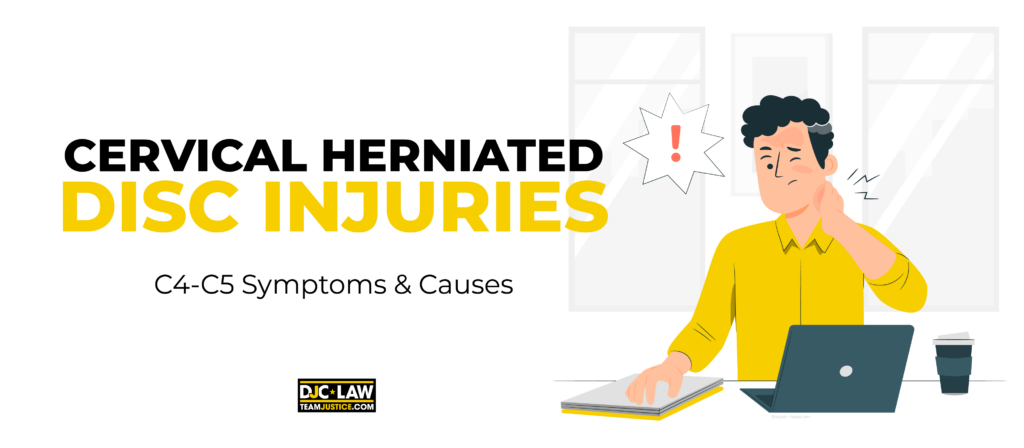
Understanding the different types of cervical herniated disc injuries can help you learn more about your treatment and any potential settlement from a personal injury lawsuit. If you’ve got neck pain, it could be related to the C4-C5 area. In this guide, we’ll discuss this specific type of injury, what it looks like, and how it’s caused.
Key Takeaways
The cervical spine is the name for the seven vertebrae at the top of the spine, numbered C1 through C7.
Between your cervical spine vertebrae are intervertebral discs that provide cushioning and shock absorption for the spine.
Forceful impacts and sharp twists can cause the spine to compress, which can force the inner part of the discs through the outer shell. Pain can result from the protruding disc putting pressure on your spine’s nerve endings.
Not all patients will experience herniated disc symptoms, and most herniated discs can be treated with rest, physiotherapy, and medication. However, some patients may require surgery.
If you have a herniated disc from an auto accident, your health insurance should cover the bills while your settlement is pending.
Working with a personal injury attorney is essential to ensuring your settlement covers your medical costs in full.
What is the Cervical Spine?
The cervical spine is a collective name for the first seven vertebrae at the top of the human spine. Your cervical spine contains seven bones numbered C1 through C7. Like the lumbar spine, the cervical spine looks like a backward C, hence the name and numbering system.
These bones are vital in supporting your head and allowing you to turn it. That’s why people with previously broken necks may be unable to turn their heads without moving their bodies. Your vertebrae also protect the spinal column, which is connected to your brain, and also act as your body’s way of keeping blood flowing to the brain.
Between each bone is something called an intervertebral disc. These discs act as cushioning and feature a gel-like substance. Here’s what your intervertebral discs consist of:
Nucleus Pulposus – The inner part of the disc is made from a gel-like substance that provides cushioning between the cervical vertebrae.
Annulus Fibrosus – This is the protective shell around the nucleus pulposus. It’s nothing more than tough fibers that protect the gel inside.
Your intervertebral discs act as shock absorbers when you move your head or neck. That’s why serious accidents can damage these discs and potentially cause permanent damage to your cervical spine.
According to Science Direct, approximately 869,000 cervical spine injuries are seen in the U.S. every year because of car accidents. It’s one of the most common injuries you’re likely to come across in an emergency room.
What are Herniated C4/C5 and C5/C6 Discs?
Herniated discs are where the inner part of a disc is forced through the outer ring due to significant trauma. Also known as ruptured and slipped discs, these injuries can appear anywhere along the spine but are most commonly found in C4-C5 or C5-C6, which are both toward the lower part of the neck.
These types of injuries most often appear due to the whiplash effect of being involved in a collision. According to Homberg Chiropractic & Wellness, more than three million cases of whiplash appear every year, and more than 50% of these cases eventually progress to display chronic symptoms.
Most startling of all is how many incidents of whiplash result in disc herniation. The Vancouver Disc Center found that 25% of all whiplash victims are also diagnosed with herniated discs.
However, herniated discs are a tricky problem because, without treatment, you can end up with chronic back pain. The complicated part of diagnosing a herniated disc is that the Mayo Clinic reported that most people never actually experience symptoms, at least in the short term.

Bulging Disc vs. Herniated Disc
Bulging discs and herniated discs are not the same. A bulging disc means the inner layer has not penetrated the outer layer of the disc, meaning it doesn’t stick out as far, and the jelly-like substance within isn’t leaking into the spinal canal.
Penn Medicine provided an easy comparison to understand the difference:
A bulging disc is like someone is letting air out of your car’s tire. On the other hand, a herniated disc has a hole or tear, meaning it’s like your tire has been slashed. Both are a problem, but a herniated disc is a more serious issue.
To the layperson looking at a herniated disc vs. bulging disc pictures, they may think they’re the same thing. However, a herniated disc protrudes out much further. The Mayo Clinic says this is why a herniated disc is likelier to cause pain because there’s a higher chance it will begin pushing against your nerve roots, resulting in inflammation and persistent pain.
What are the Common C4-C5 Herniated Disc Symptoms?
C4-C5 herniations can be spotted by their characteristic pain and weakness in the shoulder and deltoid muscles. Occasionally, patients may report tingling and numbness, but these symptoms are more familiar to C5-C6 herniated discs.
You may not notice the symptoms of a herniated disc immediately because they often don’t appear until the days and weeks after the accident. Most patients aren’t diagnosed immediately, but their symptoms usually send them back to a doctor later.
Let’s run through the symptoms of a herniated disc:
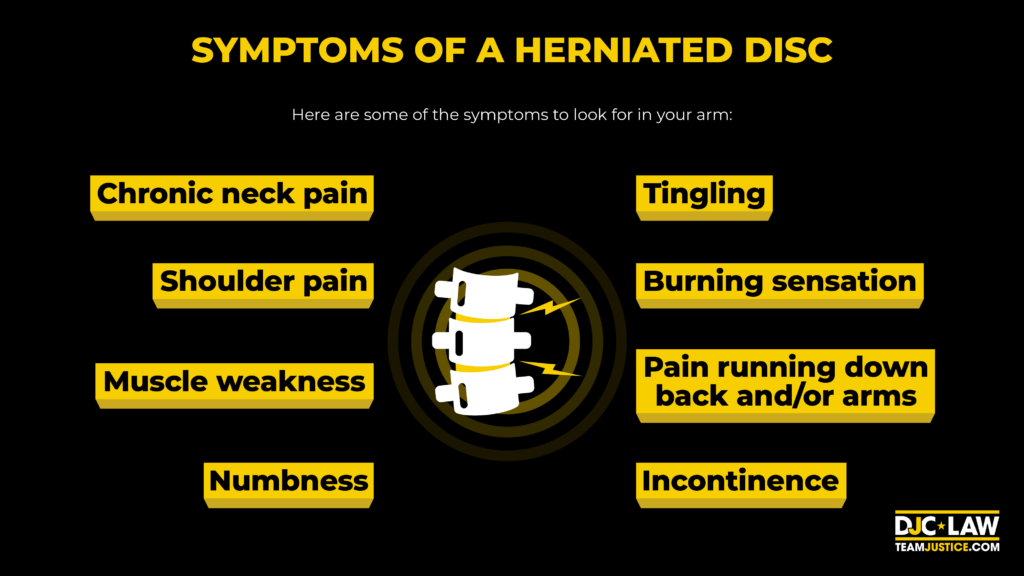
Chronic neck pain
Shoulder pain
Muscle weakness
Numbness
Tingling
Burning sensation
Pain running down your back and/or arms
Incontinence
Which symptoms you’ll encounter depends on where the cervical herniated disc is. C4-C5 herniations usually lead to weakness in the shoulder muscle. However, a C5-C6 herniation often causes muscle weakness in the bicep muscles of the upper arm.
Pain is common to all herniations because a slipped disc puts pressure on the nerve roots in your neck. Plus, if the jelly-like substance in the inner disc starts leaking into the spinal canal, this could also irritate your nerve endings and cause inflammation.
What are the Symptoms of C4-C5 Nerve Damage?
The symptoms of C4-C5 nerve damage manifest themselves as pain, numbness, and a tingling sensation. All symptoms of a herniated disc arise from the nerves in your neck becoming irritated and inflamed because the disc presses on them.
Many people automatically assume they would know if they’ve got a herniated disc, but this isn’t true. The Desert Institute for Spine Care found that 2% of Americans experience a slipped disc annually, but many don’t seek medical help because they don’t have any symptoms.
The American Association of Neurological Surgeons says that if you’ve got a herniated disc and it’s not pressing on a nerve, you might not experience any back pain. However, when it does press on a nerve, this is when you’ll start displaying symptoms. So, if you’ve got nerve damage, you’ll show symptoms.
How Does a Cervical Disc Herniate?
A herniated disc after a car accident happens because of the force of the crash that causes one of the bones in your spine to push into the spinal canal. If the bone subsequently causes compression, this can force one of your discs to herniate, resulting in the disc pressing onto the nerves in your spinal cord.
Most disc herniations happen at the C4-C5 or C5-C6 portion of the cervical spine because car accidents often lead to the whipping motion known as whiplash. The stronger the force, the greater the chance that one of your discs will herniate.
What are the Main Causes for Cervical Herniated Discs at C4-C5 and C5-C6?
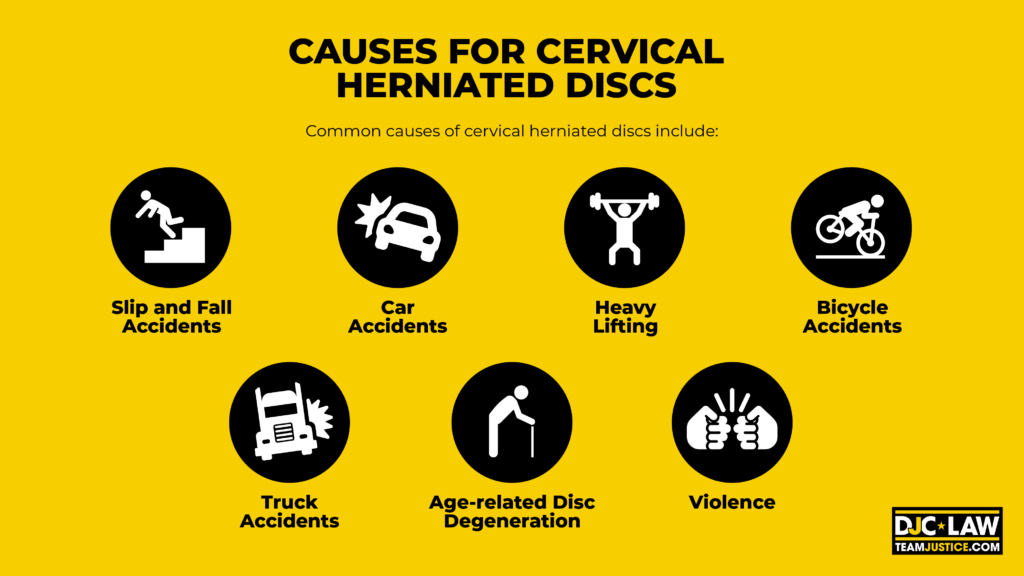
The leading causes of cervical herniated discs include but are not limited to car accidents, work-related accidents, and general wear and tear as you get older. Any significant force to the cervical spine could result in a herniated disc.
Common causes of cervical herniated discs include:
Slip and fall accidents
Car accidents
Heavy lifting
Bicycle accidents
Truck accidents
Age-related disc degeneration
Violence
Technically, any form of sharp twisting motion places pressure on your discs. If the force is significant enough, it could tear or damage the discs, letting the gel-like substance leak into the spinal column and irritate your nerve roots.
Aside from traumatic events like car accidents, a surprising number of people are diagnosed with herniated discs during their daily routines. It could be they lifted something heavy or engaged in a recreational activity. The problem is that symptoms are often delayed, which is why you must know the delayed injury symptoms to look for after a car accident to ensure your herniated disc doesn’t become chronic.
C4-C5 Disc Herniation Treatment & Recovery Time
C4-C5 disc herniations are treated with rest, pain relief medication, and physical therapy as part of the first step to recovery. Spinal injections may also be used, with severe cases involving surgery. Most people can return to regular activity within a few weeks of their treatment plans.
Treating a C4-C5 herniation is relatively simple. The National Institutes of Health found that most patients experience their symptoms disappearing after six weeks of treatment. Generally, surgery is only used as a last resort option due to the inherent risks of surgery involving the neck and spine.
Surgery is usually only recommended if all other treatment options have been exhausted or you have trouble standing and walking. Patients who lose bladder or bowel control will be recommended for surgery immediately.
However, your treatment plan will usually begin with one or more of the following:
Rest
Muscle relaxants
Pain medication
Physical therapy
NSAIDs
Steroid injections
Nerve root injections
Never ignore symptoms of a disc herniation or attempt to treat yourself. All treatment should be performed under the close supervision of a doctor. If all goes well, you can expect to return to your normal activities in roughly six weeks.
Patients who require surgery also have relatively short recovery times, with most disc herniation surgical patients resuming their usual lives in eight to twelve weeks.
Will My Insurance Company Cover My Medical Bills?
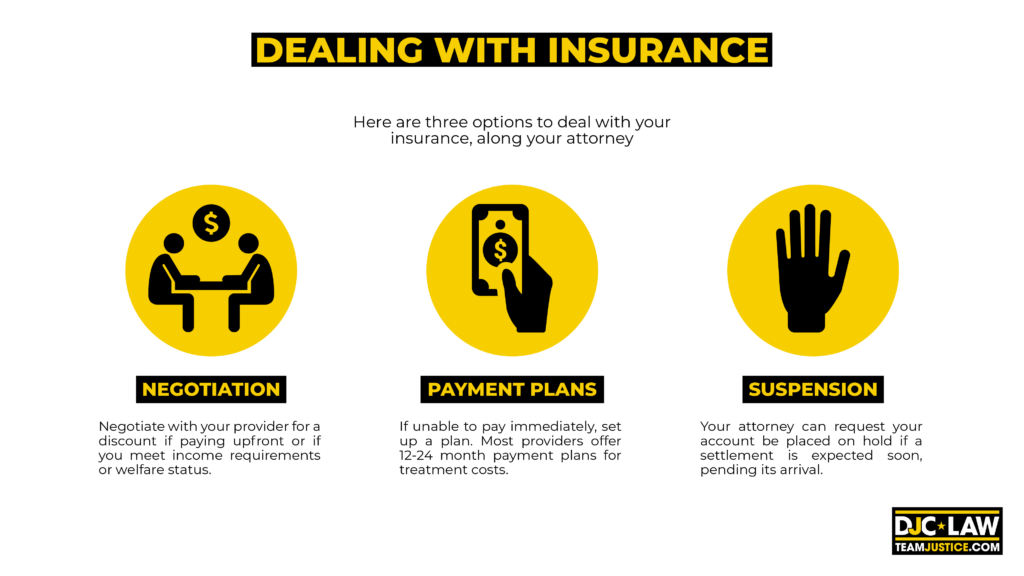
Your insurance company may cover your medical bills, depending on whether you live in an at-fault or no-fault state. In a no-fault state, parties can seek medical bill reimbursement through their own insurance company. In at-fault states, you’ll seek recompense from the at-fault driver’s insurance company.
But settlements can take months and even years to obtain, especially in at-fault states where there’s a debate over which driver was responsible. That’s why you’ll begin by paying your medical bills from your own insurance and your insurer will seek reimbursement through your settlement later.
No insurer will immediately pay your medical bills in the days after your accident because it takes them time to approve or deny your claim.
Unfortunately, this can be a problem, especially if you don’t have health insurance or your insurance won’t cover the costs of your neck injuries. That’s why working with an Austin personal injury lawyer is so critical because they can act on your behalf to help explore your options and enable you to get the care you need.
Here are your three options:
Negotiation – One option is to negotiate with your medical provider. For example, if you agree to pay everything upfront, you might be entitled to a discount. Also, you may qualify for discounts automatically if your income is below a certain threshold or you receive money from a specific welfare program.
Payment Plans – Another option if you can’t pay your medical bills immediately is to set up a payment plan. Most providers offer payment plans between 12 and 24 months to help spread the cost of your treatment.
Suspension – If you’re expecting a settlement to come in soon, your personal injury attorney can explain this to your medical providers. With an established timeline and an estimated amount, your medical provider may place your account on hold until your expected settlement comes through.
Regardless of your options, it’s critical to work with a professional who can handle everything on your behalf. Your lawyer has the experience needed to negotiate your medical bills and enable you to avoid getting into financial trouble because of your medical expenses.
What if My Medical Bills Are More than My Settlement?
If your medical bills exceed your car accident settlement, you have options. Check for limitations and clauses that could reduce your medical expenses. Negotiate with your insurer to cover excess medical costs or even lodge another personal injury lawsuit against another party, such as the other driver’s insurance company.
Experiencing a scenario where you’re asking, “What if my medical bills are more than my settlement?” can be soul-destroying, but you have options. For example, your settlement agreement may have a clause that allows them to cover excess medical costs.
Moreover, if your insurer’s settlement isn’t sufficient, you can’t lodge another claim against them, but you can lodge a claim against the other party’s insurer. Likewise, you might be able to file a civil suit against the other driver if they don’t have insurance or don’t have sufficient insurance.
Negotiating a Higher Settlement for Medical Bills
Proving the extent of your injuries and avoiding lowball settlement offers allows you to avoid a situation where your settlement doesn’t cover your medical costs. Hire an Austin personal injury lawyer to boost the size of your settlement so you don’t get into this scenario in the first place.
Getting a higher settlement for your medical bills means proving your losses are higher than anticipated and demonstrating the other driver was at fault.
Here’s a rundown of the factors that could lead to a higher settlement:
Your Injuries – Demonstrating how your cervical herniated disc has impacted your life can lead to a higher settlement. For example, if your slipped disc is so severe that you have to undergo surgery, this would boost your settlement award because of higher medical bills.
Liability – Negligence matters because if you were partially to blame for your accident in an at-fault state it will reduce your compensation amount. Your Austin personal injury lawyer has to show that the other driver was 100% at fault to maximize your compensation award.
Current and Future Medical Treatment – If your cervical disc herniation requires long-term treatment or expensive surgery, your settlement should cover this. For example, if your surgery is only partially successful and you require long-term care, this would contribute to a higher settlement award.
Lost Wages – Time off work is another crucial part of calculating your settlement award. Every lost shift counts. Moreover, if you cannot return to work at all, your attorney can claim for future lost wages and earning potential.
Pain and Suffering – A herniated cervical disc might be a physical injury, but there’s also the mental and emotional toil to take into account. That could include general loss of enjoyment of life and loss of companionship.
Most incidents where people find themselves unable to pay their medical bills because their settlements weren’t high enough result from accepting lowball offers or not seeking legal counsel. Hiring a personal injury attorney to fight your corner ensures you get every dollar you’re entitled to.
Cervical Herniated Disc Injuries FAQs
How serious is a C4-C5 herniated disc?
Most people recover fully from C4-C5 cervical disc herniations, but extreme cases can happen. In rare cases, patients might lose bowel/bladder control or even suffer from paralysis. Serious cervical herniated disc symptoms always necessitate surgery to improve spinal cord dysfunction.
How long does it take to recover from a C4-C5 herniated disc surgery?
Surgical treatment is considered a last resort option when all other treatments have failed to improve or eliminate symptoms. Most people can return to light activities, like driving, within a week of surgery, but full recovery ranges from eight to twelve weeks.
Your recovery will depend on you as a person, with some patients recovering faster than others. It’s vital to consult your doctor on what you can and can’t do during your recovery to ensure you don’t cause further damage.
Do you ever fully recover from a herniated disc?
Your herniated disc may heal on its own, meaning you’ll experience no symptoms. On the other hand, a herniated disc never fully returns to how it was before. Your herniation enters remission, where the disc automatically shrinks or dries up.
Naturally, suffering a herniated disc could cause problems as you get older, but the right treatment can keep your symptoms at bay. Most people with herniated discs live their lives completely pain-free.
